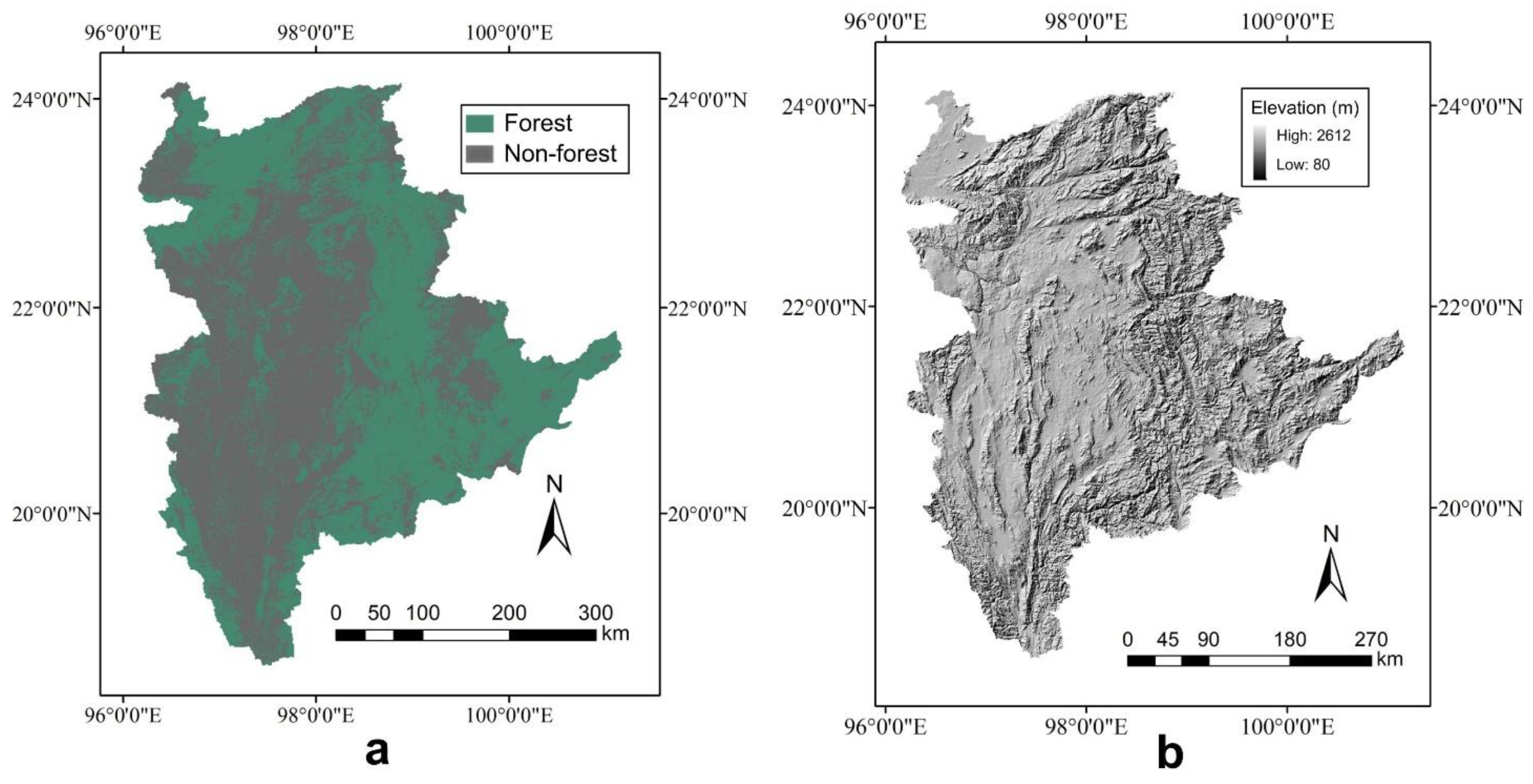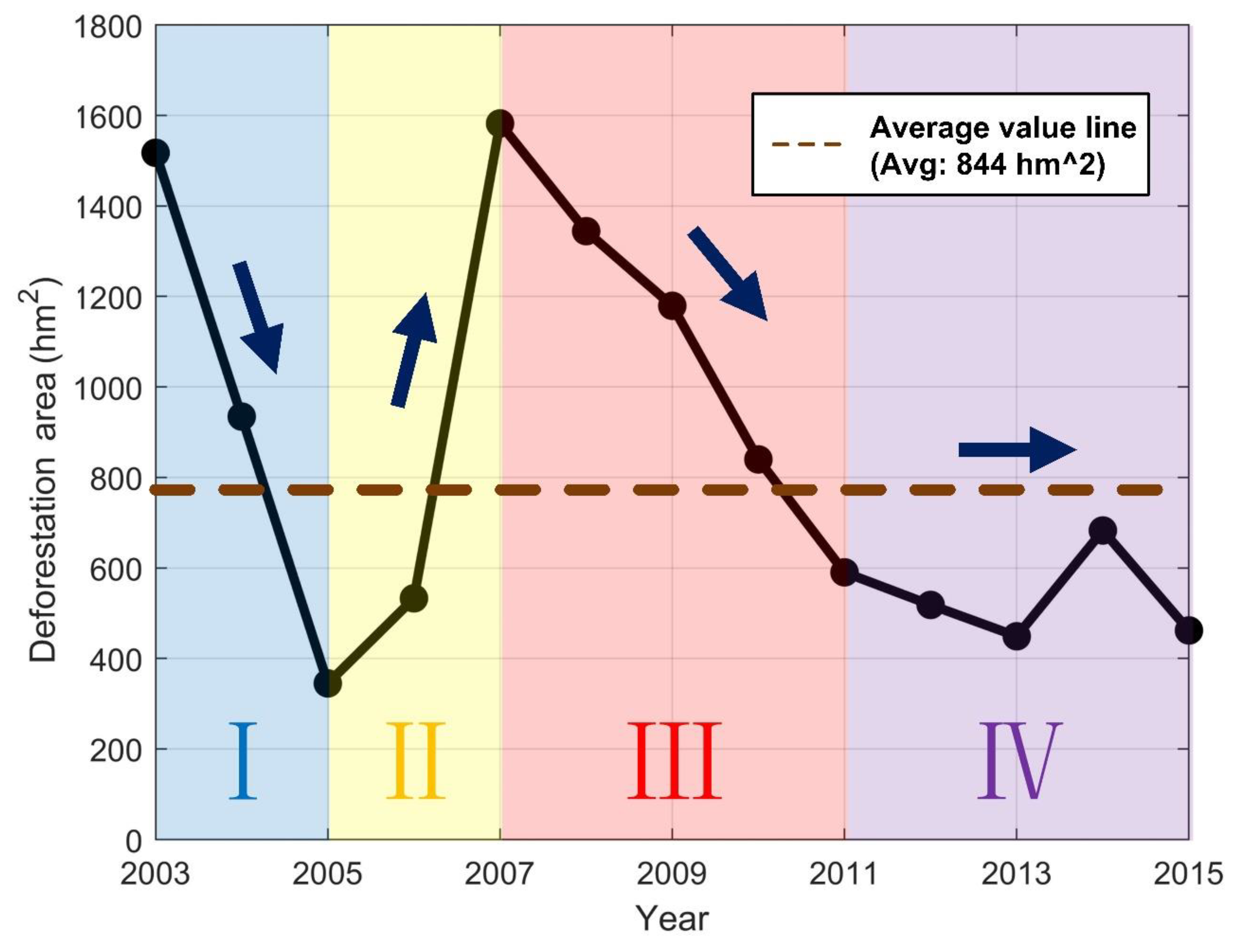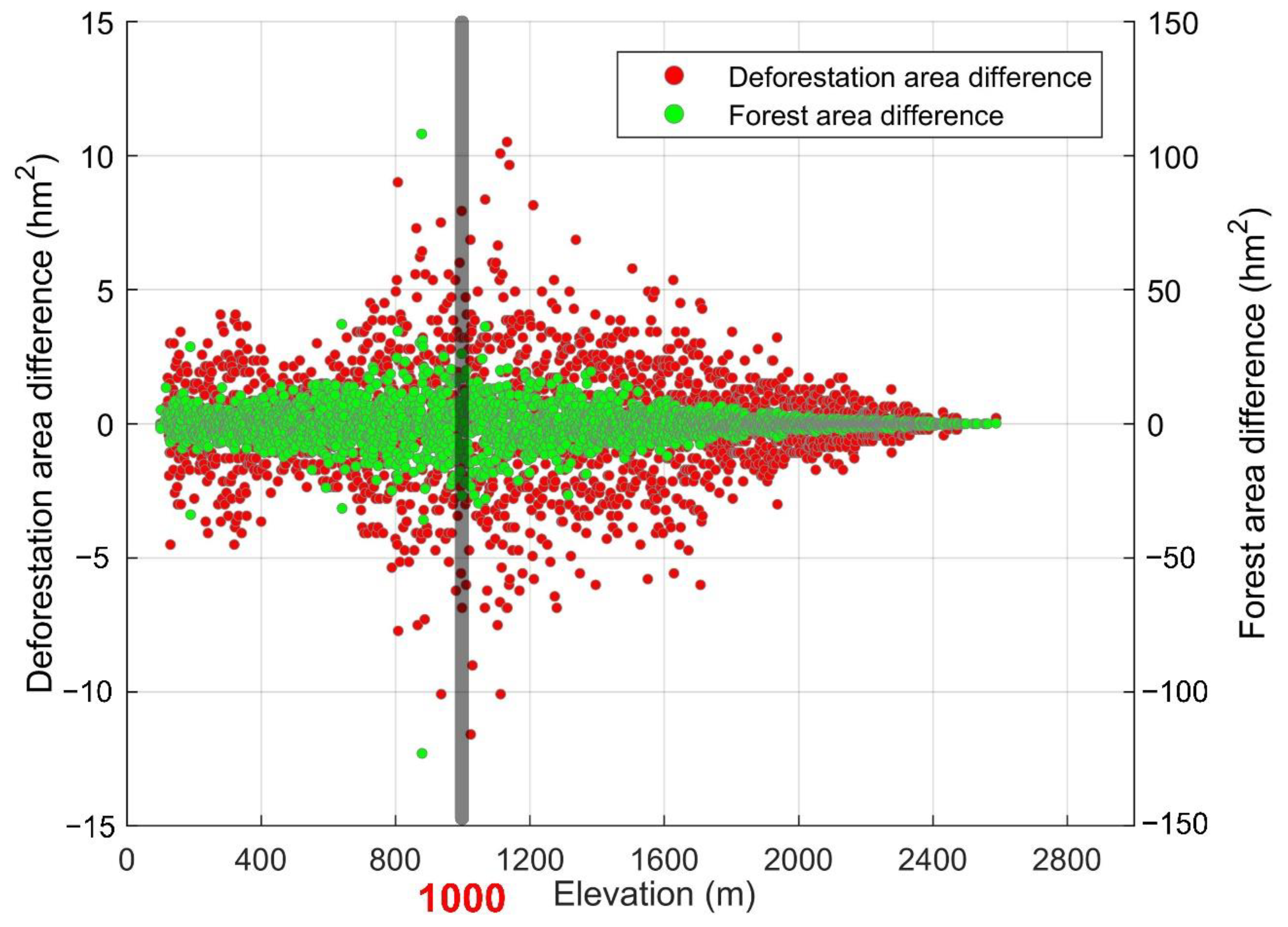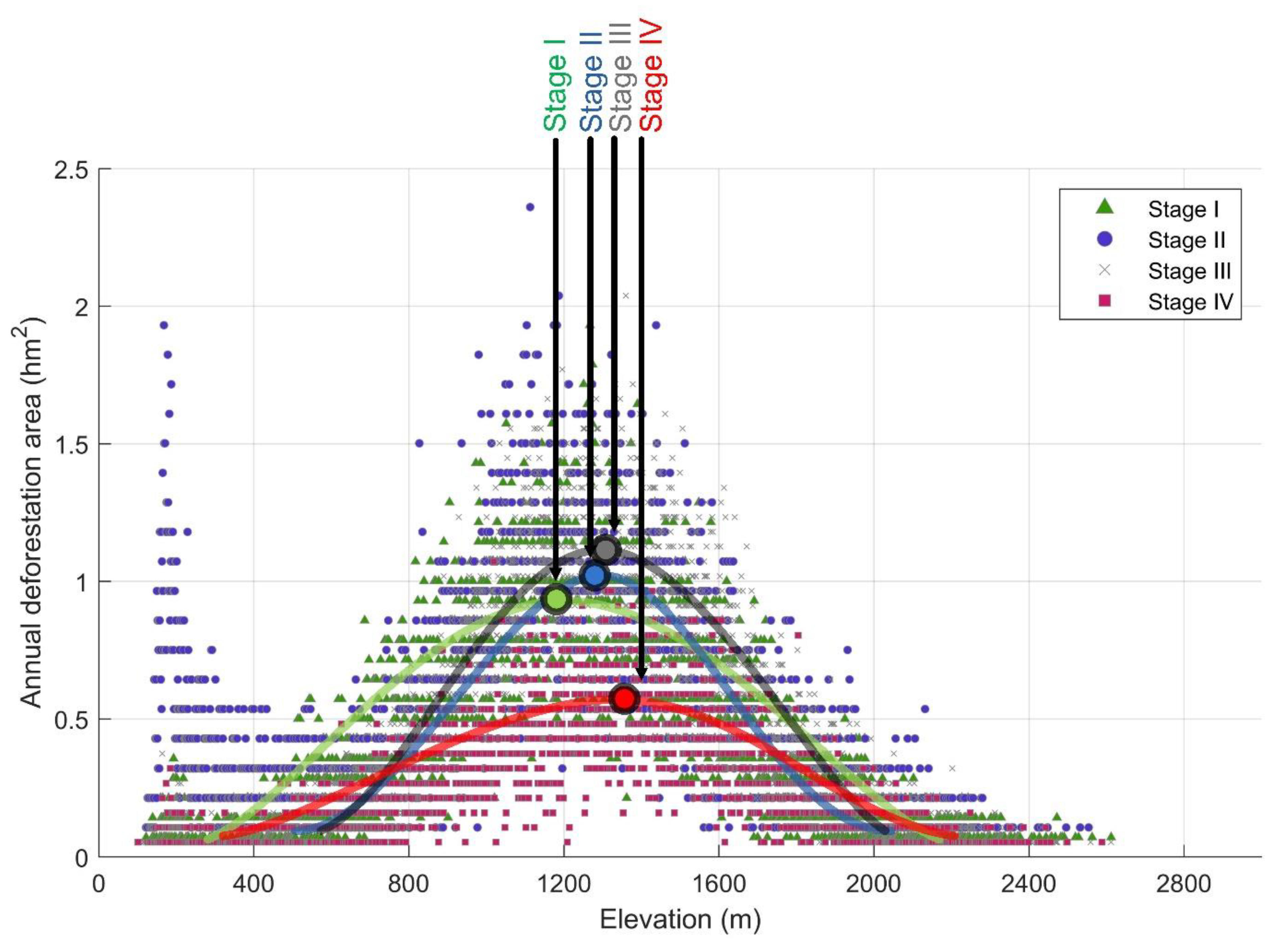Assessing Elevation-Based Forest Dynamics over Space and Time toward REDD+ MRV in Upland Myanmar
Abstract
1. Introduction
2. Materials and Methods
2.1. Research Area
2.2. Data Standardization and Forest Masking
2.3. Integrated Forest Score for Individual Forest Area Description
2.4. Savitzky–Golay Filtering to Calculate the Enhanced Integrated Forest Score
2.5. Highly Automated Vegetation Change Tracker
3. Results
3.1. Accuracy Estimation
3.2. Spatio-Temporal Analysis to Assess Deforestation in the Study Area
3.2.1. Temporal Change
3.2.2. Spatial Distribution
3.3. Elevation-Based Deforestation Dynamics
3.3.1. Elevation-Based Analysis for the Deforestation and Forest Areas
3.3.2. Elevation-Based Analysis for Deforestation Stages
3.3.3. The “Golden Cross” among the Elevation Segments
4. Discussion
4.1. High Applicability of the Enhanced Integrated Forest Score and Vegetation Change Tracker for REDD+ MRV
4.2. Shifting of the Center of Elevation of the Deforestation Area
4.3. Human-Driven Deforestation Patterns
4.4. The “Golden Cross” Due to Exacerbation of Human Activity
5. Conclusions
Author Contributions
Funding
Data Availability Statement
Conflicts of Interest
References
- Walker, X.J.; Rogers, B.M.; Veraverbeke, S.; Johnstone, J.F.; Baltzer, J.L.; Barrett, K.; Bourgeau-Chavez, L.; Day, N.J.; de Groot, W.J.; Dieleman, C.M.; et al. Fuel availability not fire weather controls boreal wildfire severity and carbon emissions. Nat. Clim. Chang. 2020, 10, 1130–1136. [Google Scholar] [CrossRef]
- Wang, Y.; Wang, Z.; Zameer, H. Structural characteristics and evolution of the “international trade-carbon emissions” network in equipment manufacturing industry: International evidence in the perspective of global value chains. Environ. Sci. Pollut. Res. Lnt. 2021, 28, 25886–25905. [Google Scholar] [CrossRef] [PubMed]
- Ngo, D.T.; Le, A.V.; Le, H.T.; Stas, S.M.; Le, T.C.; Tran, H.D.; Pham, T.; Le, T.T.; Spracklen, B.D.; Langan, C.; et al. The potential for REDD+ to reduce forest degradation in Vietnam. Environ. Res. Lett. 2020, 15, 074025. [Google Scholar] [CrossRef]
- Villa, P.M.; Martins, S.V.; de Oliveira Neto, S.N.; Rodrigues, A.C.; Hernández, E.P.; Kim, D.G. Policy forum: Shifting cultivation and agroforestry in the Amazon: Premises for REDD+. For. Policy Econ. 2020, 118, 102217. [Google Scholar] [CrossRef]
- Csillik, O.; Kumar, P.; Asner, G.P. Challenges in estimating tropical forest canopy height from planet dove imagery. Remote Sens. 2020, 12, 1160. [Google Scholar] [CrossRef]
- Silva, J.M.N.; Carreiras, J.M.B.; Rosa, I.; Pereira, J.M.C. Greenhouse gas emissions from shifting cultivation in the tropics, including uncertainty and sensitivity analysis. J. Geophys. Res. Atmos. 2011, 116, D20304. [Google Scholar] [CrossRef]
- Corbera, E.; Schroeder, H. Governing and implementing REDD+. Environ. Sci. Policy 2011, 14, 89–99. [Google Scholar] [CrossRef]
- Hargita, Y.; Günter, S.; Köthke, M. Brazil submitted the first REDD+ reference level to the UNFCCC—Implications regarding climate effectiveness and cost-efficiency. Land Use Policy 2016, 55, 340–347. [Google Scholar] [CrossRef]
- Andoh, J.; Lee, Y. National REDD+ strategy for climate change mitigation: A review and comparison of developing countries. Sustainability 2018, 10, 4781. [Google Scholar] [CrossRef]
- Sandker, M.; Carrillo, O.; Leng, C.; Lee, D.; d’Annunzio, R.; Fox, J. The Importance of High–Quality Data for REDD+ Monitoring and Reporting. Forests 2021, 12, 99. [Google Scholar] [CrossRef]
- Pham, T.T.; Moeliono, M.; Yuwono, J.; Dwisatrio, B.; Gallo, P. REDD+ finance in Brazil, Indonesia, and Vietnam: Stakeholder perspectives between 2009-2019. Glob. Environ. Chang. 2021, 70, 102330. [Google Scholar] [CrossRef]
- Luttrell, C.; Loft, L.; Gebara, M.F.; Kweka, D.; Brockhaus, M.; Angelsen, A.; Sunderlin, W.D. Who should benefit from REDD+? Rationales and realities. Ecol. Soc. 2013, 18, 52. [Google Scholar] [CrossRef]
- Hoang, M.H.; Do, T.H.; Pham, M.T.; Van Noordwijk, M.; Minang, P.A. Benefit distribution across scales to reduce emissions from deforestation and forest degradation (REDD+) in Vietnam. Land Use Policy 2013, 31, 48–60. [Google Scholar] [CrossRef]
- Karsenty, A.; Vogel, A.; Castell, F. Carbon rights, REDD+ and payments for environmental services. Environ. Sci. Policy 2014, 35, 20–29. [Google Scholar] [CrossRef]
- Nyamari, N.; Cabral, P. Impact of land cover changes on carbon stock trends in Kenya for spatial implementation of REDD+ policy. Appl. Geogr. 2021, 133, 102479. [Google Scholar] [CrossRef]
- Cappello, C.; Pratihast, A.K.; Pérez Ojeda del Arco, A.; Reiche, J.; De Sy, V.; Herold, M.; Vivanco Vicencio, R.E.; Castillo Soto, D. Alert-Driven Community-Based Forest Monitoring: A Case of the Peruvian Amazon. Remote Sens. 2022, 14, 4284. [Google Scholar] [CrossRef]
- Aryal, R.R.; Wespestad, C.; Kennedy, R.; Dilger, J.; Dyson, K.; Bullock, E.; Khanal, N.; Kono, M.; Poortinga, A.; Saah, D.; et al. Lessons Learned While Implementing a Time-Series Approach to Forest Canopy Disturbance Detection in Nepal. Remote Sens. 2021, 13, 2666. [Google Scholar] [CrossRef]
- Fry, B.P. Community forest monitoring in REDD+: The ‘M’in MRV? Environ. Sci. Policy 2011, 14, 181–187. [Google Scholar]
- Tun, Z.N.; Dargusch, P.; McMoran, D.J.; McAlpine, C.; Hill, G. Patterns and Drivers of Deforestation and Forest Degradation in Myanmar. Sustainability 2021, 13, 7539. [Google Scholar]
- Herold, M.; Skutsch, M.M. Measurement, reporting and verification for REDD+: Objectives, capacities and institutions. In Realising REDD+: National Strategy and Policy Options; Angelsen, A., Brockhaus, M., Eds.; Center for International Forestry Research: Bogor, Indonesia, 2009; pp. 84–100. ISBN 978-6-02-869303-5. [Google Scholar]
- Goslee, K.M.; Pearson, T.R.; Bernal, B.; Simon, S.L.; Sukhdeo, H. Comprehensive Accounting for REDD+ Programs: A Pragmatic Approach as Exemplified in Guyana. Forests 2020, 11, 1265. [Google Scholar] [CrossRef]
- Biswas, S.; Huang, Q.; Anand, A.; Mon, M.S.; Arnold, F.E.; Leimgruber, P. A multi sensor approach to forest type mapping for advancing monitoring of sustainable development goals (SDG) in Myanmar. Remote Sens. 2020, 12, 3220. [Google Scholar] [CrossRef]
- Soe, K.T.; Yeo-Chang, Y.O.U.N. Perceptions of forest-dependent communities toward participation in forest conservation: A case study in Bago Yoma, South-Central Myanmar. Forest Policy Econ. 2019, 100, 129–141. [Google Scholar] [CrossRef]
- Michinaka, T.; Hlaing, E.E.S.; Oo, T.N.; Mon, M.S.; Sato, T. Forecasting forest areas in Myanmar based on socioeconomic factors. Forests 2020, 11, 100. [Google Scholar] [CrossRef]
- Reddy, C.S.; Pasha, S.V.; Satish, K.V.; Unnikrishnan, A.; Chavan, S.B.; Jha, C.S.; Diwakar, P.G.; Dadhwal, V.K. Quantifying and predicting multi-decadal forest cover changes in Myanmar: A biodiversity hotspot under threat. Biodivers. Conserv. 2019, 28, 1129–1149. [Google Scholar] [CrossRef]
- Schmid, M.; Heinimann, A.; Zaehringer, J.G. Patterns of land system change in a Southeast Asian biodiversity hotspot. Appl. Geogr. 2021, 126, 102380. [Google Scholar] [CrossRef]
- Wang, C.; Myint, S.W. Environmental concerns of deforestation in Myanmar 2001–2010. Remote Sens. 2016, 8, 728. [Google Scholar] [CrossRef]
- Shimizu, K.; Ota, T.; Mizoue, N.; Yoshida, S. Patch-Based Assessments of Shifting Cultivation Detected by Landsat Time Series Images in Myanmar. Sustainability 2018, 10, 3350. [Google Scholar] [CrossRef]
- Swe, K.N.; Nawata, E. Changing Practices from Swidden to Permanent Agriculture in Traditional Swidden Cultivation Areas-Case Studies in Three Karen Villages of the Bago Mountains, Myanmar. Trop. Agric. Develop. 2020, 64, 80–89. [Google Scholar]
- Fukushima, M.; Kanzaki, M.; Thein, H.M. Recovery process of fallow vegetation in the traditional Karen swidden cultivation system in the Bago mountain range, Myanmar. Southeast Asian Stud. 2007, 45, 317–333. [Google Scholar]
- Angelsen, A. Shifting cultivation and “deforestation”: A study from Indonesia. World Dev. 1995, 23, 1713–1729. [Google Scholar] [CrossRef]
- Paul, S.; Das, T.K.; Pharung, R.; Ray, S.; Mridha, N.; Kalita, N.; Ralte, V.; Borthakur, S.; Burman, R.R.; Tripathi, A.K.; et al. Development of an indicator based composite measure to assess livelihood sustainability of shifting cultivation dependent ethnic minorities in the disadvantageous Northeastern region of India. Ecol. Indic. 2020, 110, 105934. [Google Scholar] [CrossRef]
- Thong, P.; Sahoo, U.K.; Thangjam, U.; Pebam, R. Pattern of forest recovery and carbon stock following shifting cultivation in Manipur, North-East India. PLoS ONE 2020, 15, e0239906. [Google Scholar] [CrossRef] [PubMed]
- Heinimann, A.; Mertz, O.; Frolking, S.; Egelund Christensen, A.; Hurni, K.; Sedano, F.; Parsons Chini, L.; Sahajpal, R.; Hansen, M.; Hurtt, G. A global view of shifting cultivation: Recent, current, and future extent. PLoS ONE 2017, 12, e0184479. [Google Scholar] [CrossRef]
- Molinario, G.; Hansen, M.C.; Potapov, P.V. Forest cover dynamics of shifting cultivation in the Democratic Republic of Congo: A remote sensing-based assessment for 2000–2010. Environ. Res. Lett. 2015, 10, 094009. [Google Scholar] [CrossRef]
- Thet, A.P.P.; Tokuchi, N. Traditional knowledge on shifting cultivation of local communities in Bago Mountains, Myanmar. J. For. Res. 2020, 25, 347–353. [Google Scholar] [CrossRef]
- Lu, S.; Zhang, C.; Lu, H. Spatio-temporal dynamics of shifting cultivation in Upland Myanmar using time series images and implications for REDD+. In Land Surface and Cryosphere Remote Sensing IV, Proceedings of International Society for Optics and Photonics, Honolulu, HI, USA, 25–26 September 2018; SPIE: Bellingham, WA, USA, 2018; Volume 10777, p. 107770O. [Google Scholar]
- Zwartendijk, B.W.; Van Meerveld, H.J.; Ghimire, C.P.; Bruijnzeel, L.A.; Ravelona, M.; Jones, J.P.G. Rebuilding soil hydrological functioning after swidden agriculture in eastern Madagascar. Agric. Ecosyst. Environ. 2017, 239, 101–111. [Google Scholar] [CrossRef]
- Das, P.; Mudi, S.; Behera, M.D.; Barik, S.K.; Mishra, D.R.; Roy, P.S. Automated Mapping for Long-Term Analysis of Shifting Cultivation in Northeast India. Remote Sens. 2021, 13, 1066. [Google Scholar] [CrossRef]
- Mon, M.S.; Mizoue, N.; Htun, N.Z.; Kajisa, T.; Yoshida, S. Factors affecting deforestation and forest degradation in selectively logged production forest: A case study in Myanmar. For. Ecol. Manag. 2012, 267, 190–198. [Google Scholar] [CrossRef]
- D’Arrigo, R.; Palmer, J.; Ummenhofer, C.C.; Kyaw, N.N.; Krusic, P. Three centuries of Myanmar monsoon climate variability inferred from teak tree rings. Geophys. Res. Lett. 2011, 38, L24705. [Google Scholar] [CrossRef]
- Zeng, Z.; Wang, D.; Yang, L.; Wu, J.; Ziegler, A.D.; Liu, M.; Ciais, P.; Searchinger, T.D.; Yang, Z.L.; Chen, D.; et al. Deforestation-induced warming over tropical mountain regions regulated by elevation. Nat. Geosci. 2021, 14, 23–29. [Google Scholar] [CrossRef]
- Rudel, T.K. Changing agents of deforestation: From state-initiated to enterprise driven processes, 1970–2000. Land Use Policy 2007, 24, 35–41. [Google Scholar] [CrossRef]
- Trujillo, E.; Molotch, N.P.; Goulden, M.L.; Kelly, A.E.; Bales, R.C. Elevation-dependent influence of snow accumulation on forest greening. Nat. Geosci. 2012, 5, 705–709. [Google Scholar] [CrossRef]
- Slot, M.; Cala, D.; Aranda, J.; Virgo, A.; Michaletz, S.T.; Winter, K. Leaf heat tolerance of 147 tropical forest species varies with elevation and leaf functional traits, but not with phylogeny. Plant Cell Environ. 2021, 44, 2414–2427. [Google Scholar] [CrossRef] [PubMed]
- Han, J.C.; Huang, Y.; Zhang, H.; Wu, X. Characterization of elevation and land cover dependent trends of NDVI variations in the Hexi region, northwest China. J. Environ. Manag. 2019, 232, 1037–1048. [Google Scholar] [CrossRef]
- Fyllas, N.M.; Bentley, L.P.; Shenkin, A.; Asner, G.P.; Atkin, O.K.; Díaz, S.; Enquist, B.J.; Farfan-Rios, W.; Gloor, E.; Guerrieri, R.; et al. Solar radiation and functional traits explain the decline of forest primary productivity along a tropical elevation gradient. Ecol. Lett. 2017, 20, 730–740. [Google Scholar] [CrossRef]
- Murray, N.J.; Keith, D.A.; Tizard, R.; Duncan, A.; Htut, W.T.; Hlaing, N.; Oo, A.H.; Ya, K.Z.; Grantham, H. Threatened Ecosystems of Myanmar. An IUCN Red List of Ecosystems Assessment, 1st ed.; Wildlife Conservation Society: Randwick, Australia, 2020; ISBN 978-0-9903852-5-7. [Google Scholar]
- Wang, Y.; Ziv, G.; Adami, M.; de Almeida, C.A.; Antunes, J.F.G.; Coutinho, A.C.; Esquerdo, J.C.D.M.; Gomes, A.R.; Galbraith, D. Upturn in secondary forest clearing buffers primary forest loss in the Brazilian Amazon. Nat. Sustain. 2020, 3, 290–295. [Google Scholar] [CrossRef]
- Bisi, F.; Gagliardi, A.; Cremonesi, G.; Colombo, R.; Mazzamuto, M.V.; Wauters, L.A.; Preatoni, D.G.; Martinoli, A. Distribution of wildlife and illegal human activities in the Lampi marine National Park (Myanmar). Environ. Conserv. 2019, 46, 163–170. [Google Scholar] [CrossRef]
- Kmoch, L.; Palm, M.; Persson, U.M.; Jepsen, M.R. Access mapping highlights risks from land reform in upland Myanmar. J. Land Use Sci. 2021, 16, 34–54. [Google Scholar] [CrossRef]
- Kmoch, L.; Palm, M.; Persson, U.M.; Rudbeck Jepsen, M. Upland livelihoods between local land and global labour market dependencies: Evidence from Northern Chin State, Myanmar. Sustainability 2018, 10, 3707. [Google Scholar] [CrossRef]
- Aung, A.K. The primate-bearing Pondaung Formation in the upland area, northwest of central Myanmar. In Anthropoid Origins; Springer: Boston, MA, USA, 2004; pp. 205–217. [Google Scholar]
- Borras, S.M., Jr.; Franco, J.C.; Nam, Z. Climate change and land: Insights from Myanmar. World Dev. 2020, 129, 104864. [Google Scholar] [CrossRef]
- D’Arrigo, R.; Ummenhofer, C.C. The climate of Myanmar: Evidence for effects of the Pacific Decadal Oscillation. Int. J. Climatol. 2015, 35, 634–640. [Google Scholar] [CrossRef]
- Sein, K.K.; Chidthaisong, A.; Oo, K.L. Observed trends and changes in temperature and precipitation extreme indices over Myanmar. Atmosphere 2018, 9, 477. [Google Scholar] [CrossRef]
- Rao, M.; Htun, S.; Platt, S.G.; Tizard, R.; Poole, C.; Myint, T.; Watson, J.E. Biodiversity conservation in a changing climate: A review of threats and implications for conservation planning in Myanmar. Ambio 2013, 42, 789–804. [Google Scholar] [CrossRef] [PubMed]
- Htun, N.Z. Biodiversity in Myanmar. In Global Biodiversity, 1st ed.; Apple Academic Press: Palm Bay, FL, USA, 2018; pp. 753–815. ISBN 9780429487743. [Google Scholar]
- Yang, R.; Luo, Y.; Yang, K.; Hong, L.; Zhou, X. Analysis of forest deforestation and its driving factors in Myanmar from 1988 to 2017. Sustainability 2019, 11, 3047. [Google Scholar] [CrossRef]
- Lim, C.L.; Prescott, G.W.; De Alban, J.D.T.; Ziegler, A.D.; Webb, E.L. Untangling the proximate causes and underlying drivers of deforestation and forest degradation in Myanmar. Conserv. Biol. 2017, 31, 1362–1372. [Google Scholar] [CrossRef] [PubMed]
- Li, Y.; Andrés, V.; Yang, W.; Chen, X.D.; Zhang, J.D.; Ouyang, Z.Y. Effects of conservation policies on forest cover change in giant panda habitat regions, China. Land Use Policy 2013, 33, 42–53. [Google Scholar] [CrossRef]
- Dong, J.; Xiao, X.; Sheldon, S.; Biradar, C.; Duong, N.D.; Hazarika, M. A comparison of forest cover maps in Mainland Southeast Asia from multiple sources: PALSAR, MERIS, MODIS and FRA. Remote Sens. Environ. 2012, 127, 60–73. [Google Scholar] [CrossRef]
- Dou, X.F.; Jiapa, A.; Li, Y.H.; Guan, Z.Z.; Wang, X.M.; Lv, Y.N.; Tian, L.L.; Li, X.; Zhang, X.C.; Sun, Y.L.; et al. Remote sensing of land coverage and investigation of plague risk among small mammals in Beijing, China. Chin. J. Vector Biol. Control 2013, 24, 43–46. [Google Scholar]
- Yan, X.U.; Zhang, J. Detecting major phenological stages of rice using MODIS-EVI data and Symlet11 wavelet in Northeast China. Acta Ecol. Sin. 2012, 7, 1–4. [Google Scholar]
- Huang, C.; Goward, S.N.; Masek, J.G.; Thomas, N.; Zhu, Z.; Vogelmann, J.E. An automated approach for reconstructing recent forest disturbance history using dense Landsat time series stacks. Remote Sens. Environ. 2010, 114, 183–198. [Google Scholar] [CrossRef]
- Huang, C.; Ling, P.Y.; Zhu, Z. North Carolina’s forest disturbance and timber production assessed using time series Landsat observations. Int. J. Digit. Earth 2015, 8, 947–969. [Google Scholar] [CrossRef]
- Huang, C.; Thomas, N.; Goward, S.N.; Masek, J.G.; Zhu, Z.; Townshend, J.R.; Vogelmann, J.E. Automated masking of cloud and cloud shadow for forest change analysis using Landsat images. Int. J. Remote Sens. 2010, 31, 5449–5464. [Google Scholar] [CrossRef]
- Huang, C.; Goward, S.N.; Schleeweis, K.; Thomas, N.; Masek, J.G.; Zhu, Z. Dynamics of national forests assessed using the Landsat record: Case studies in eastern United States. Remote Sens. Environ. 2009, 113, 1430–1442. [Google Scholar] [CrossRef]
- Chen, J.; Jönsson, P.; Tamura, M.; Gu, Z.; Matsushita, B.; Eklundh, L. A simple method for reconstructing a high-quality NDVI time-series data set based on the Savitzky–Golay filter. Remote Sens. Environ. 2004, 91, 332–344. [Google Scholar] [CrossRef]
- Gebhardt, S.; Wehrmann, T.; Ruiz, M.A.M.; Maeda, P.; Bishop, J.; Schramm, M.; Kopeinig, R.; Cartus, O.; Kellndorfer, J.; Ressl, R.; et al. MAD-MEX: Automatic wall-to-wall land cover monitoring for the Mexican REDD-MRV program using all Landsat data. Remote Sens. 2014, 6, 3923–3943. [Google Scholar] [CrossRef]
- Herold, M.; Skutsch, M. Monitoring, reporting and verification for national REDD+ programmes: Two proposals. Environ. Res. Lett. 2011, 6, 014002. [Google Scholar] [CrossRef]
- Liao, C.; Feng, Z.; Li, P.; Zhang, J. Monitoring the spatio-temporal dynamics of swidden agriculture and fallow vegetation recovery using Landsat imagery in northern Laos. J. Geogr. Sci. 2015, 25, 1218–1234. [Google Scholar] [CrossRef]
- Chan, N.; Takeda, S.; Suzuki, R.; Yamamoto, S. Assessment of biomass recovery and soil carbon storage of fallow forests after swidden cultivation in the Bago Mountains, Myanmar. New For. 2016, 47, 565–585. [Google Scholar] [CrossRef]
- Leimgruber, P.; Kelly, D.S.; Steininger, M.K.; Brunner, J.; Müller, T.; Songer, M. Forest cover change patterns in Myanmar (Burma) 1990–2000. Environ. Conserv. 2005, 32, 356–364. [Google Scholar] [CrossRef]
- Vicol, M.; Pritchard, B.; Htay, Y.Y. Rethinking the role of agriculture as a driver of social and economic transformation in Southeast Asia’s upland regions: The view from Chin State, Myanmar. Land Use Policy 2018, 72, 451–460. [Google Scholar] [CrossRef]








Publisher’s Note: MDPI stays neutral with regard to jurisdictional claims in published maps and institutional affiliations. |
© 2022 by the authors. Licensee MDPI, Basel, Switzerland. This article is an open access article distributed under the terms and conditions of the Creative Commons Attribution (CC BY) license (https://creativecommons.org/licenses/by/4.0/).
Share and Cite
Lu, S.; Zhang, C.; Dong, J.; Adil, M.; Lu, H. Assessing Elevation-Based Forest Dynamics over Space and Time toward REDD+ MRV in Upland Myanmar. Remote Sens. 2022, 14, 6117. https://doi.org/10.3390/rs14236117
Lu S, Zhang C, Dong J, Adil M, Lu H. Assessing Elevation-Based Forest Dynamics over Space and Time toward REDD+ MRV in Upland Myanmar. Remote Sensing. 2022; 14(23):6117. https://doi.org/10.3390/rs14236117
Chicago/Turabian StyleLu, Siqi, Chuanrong Zhang, Jinwei Dong, Muhammad Adil, and Heli Lu. 2022. "Assessing Elevation-Based Forest Dynamics over Space and Time toward REDD+ MRV in Upland Myanmar" Remote Sensing 14, no. 23: 6117. https://doi.org/10.3390/rs14236117
APA StyleLu, S., Zhang, C., Dong, J., Adil, M., & Lu, H. (2022). Assessing Elevation-Based Forest Dynamics over Space and Time toward REDD+ MRV in Upland Myanmar. Remote Sensing, 14(23), 6117. https://doi.org/10.3390/rs14236117








